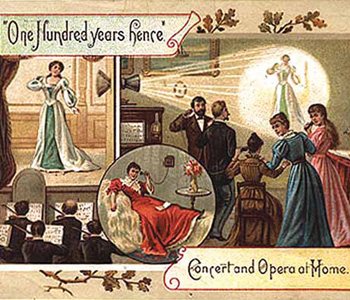Light Touch
From Telephote to Television: A Fantastic Journey
Unlike the telephone, the television did not have one clear inventor. It was shaped over decades by the minds of researchers as well as science fiction writers. When it was first conceived and developed, a device that could instantaneously transmit images was referred to as a “telephote.”

 (Top) A late-1800s trade card predicting what life will be like in 2000. (Bottom) A modern flat-screen TV.
(Top) A late-1800s trade card predicting what life will be like in 2000. (Bottom) A modern flat-screen TV.
In 1880, Alexander Graham Bell, inventor of the telephone, sent a sealed package to the Smithsonian Institution in Washington, D.C. The contents were to be revealed at an upcoming meeting of the American Association for the Advancement of Science—but rumors soon began swirling about its contents. According to the 15 April 1880 issue of Nature, Bell’s new device would be able to transmit light in the same way that the telephone transmits sound. It would be called the telephote, which derives from the Greek roots for “far” and “light.”
…Log in or become a member to view the full text of this article.
This article may be available for purchase via the search at Optica Publishing Group.
Optica Members get the full text of Optics & Photonics News, plus a variety of other member benefits.
